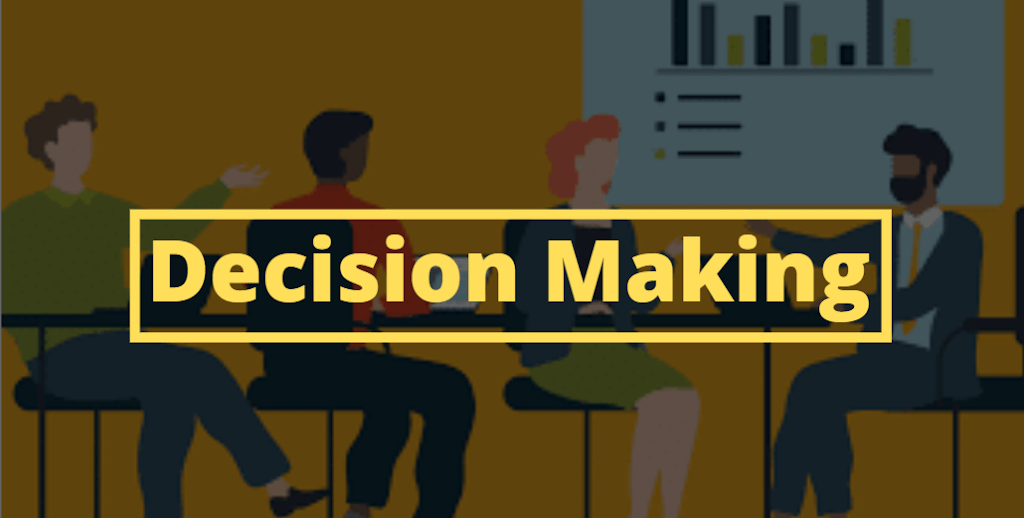What you are going to learn?
What is Decision making in management?

Types of decision making
- Programmed and non-programmed decision.
- Major and minor decision.
- Routine and strategic decision.
- Organizational and personal decision.
- Individual and group decision.
- Policy and operational decision.
- Long-term, departmental, and non-economic decision.
Programmed and non-programmed decisions
Programmed decisions are those that adhere to habits, rules, or procedures. Each organization has its own policies to streamline decision-making.
For instance, determining the salary of a new employee is not a concern as the organization typically follows a set salary scale for all positions.
While programmed decisions may limit our autonomy to some extent, they allow the organization rather than an individual to dictate actions.
Nevertheless, the policies, rules, and procedures guiding our decisions enable us to consider alternative solutions and focus on other, more critical tasks.
Non-programmed decisions, on the other hand, address unique problems. If an issue is not covered by existing policies or is of significant importance, it requires special treatment through non-programmed decision-making.
- How to allocate an organization’s resources.
- What to do about failing product line.
- How community relations should be improved will usually require non-programmed decisions.
2. Major and minor decision
Making the decision to purchase expensive equipment, such as purchasing a CNC is considered a major decision.
The purchase of cheap equipment like a few reams of typing paper is a minor decision.Making major decisions requires careful consideration and analysis of the potential impact on the business, while minor decisions can often be made quickly and without much thought. It’s important for businesses to prioritize major decisions and allocate resources accordingly to ensure long-term success.
3. Routine and strategic decisions
4. Organizational and Personal decision
A manager makes organizational decisions on behalf of a company’s officer. This type of decision reflects the organization’s policy.
Personal decisions are the manager’s individual choice, not made as a representative of the organization. In other words, a manager’s personal decisions are based on their own preferences, beliefs, and values, rather than following a set policy or guideline set by the company. These decisions may not always align with the best interests of the organization, as they are made from a more personal perspective.
5. Individual and group decision
6. policy and operative decisions
7. Long term, departmental and non-economic decision
Importance of decision making
-
Imagine your life as a vast, winding road. At every turn, you’re faced with a choice: take the scenic route or the shortcut? Stop for coffee or power through? Change careers or stay the course? The ability to navigate these crossroads, big and small, is what decision-making is all about. It’s the fundamental skill that shapes our paths and ultimately, our destinies.
Why are good decisions so crucial?
-
Direction and Goals: Effective decision-making sets the compass for our lives. By weighing options and considering consequences, we define our goals and steer ourselves towards what we truly value.
-
Problem-Solving Prowess: Life throws curveballs. But through well-honed decision-making, we learn to analyze situations, identify the best course of action, and overcome challenges with confidence.
-
Empowerment and Growth: Every decision, successful or not, is a learning experience. It hones our critical thinking, builds resilience, and equips us to tackle future choices with greater self-assurance.
Beyond the Basics: Strategies for Smarter Decisions
Making good decisions isn’t about blind intuition. Here are some tools to elevate your decision-making game:
-
Gather Information: Knowledge is power. Before diving in, research your options, gather data, and consult with experts if needed. The more informed you are, the stronger your decision will be.
-
Consider All Sides: Don’t get caught in tunnel vision. Evaluate the potential pros and cons of each choice. Think about how your decision might impact yourself and others.
-
Listen to Your Gut (but also your head): Intuition can be a powerful tool, but don’t rely solely on gut feelings. Balance your intuition with a logical analysis of the facts at hand.
-
Don’t Be Afraid to Adapt: The world is rarely black and white. Be prepared to adjust your course of action if circumstances change. Flexibility is key in a dynamic world.
-
Decision-making techniques
| Type of decision making | Traditional Technique | Modern Technique |
| 1. Programmed: Routine, repetitive decisions, an organization develops a specific process for handling them. |
(i) Based on habit
(ii) critical routine standard operating procedure. (iii) organization structure. |
(i) Operation research, mathematical analysis, models, computer simulation.
(ii) Data processing. |
| 2. Non-programmed: Non-routine, one-shot, ill-structured, novel policy decisions handled by the general problem-solving process. |
(i) Judgment, intuition, and creativity.
(ii) Rule of thumb. (iii) selection and training of executives. |
(i) Training human decision-makers.
(ii) Constructing heuristic computer Programs. |
Decision Making Process
Using a step by step process for any decision making within an organization can help to make a more deliberate and effective decision. So steps of effective decision making are discussed below.
Step 1: Identify the Decision:
When you realize that you have to make a decision try to identify and clearly define the nature of decision you are going to make. It will help you to make effective decision.
Step 2: Gather relevant information:
Before decision making, it is important to gather all information relevant to your decision making. The source of information can be two types, First one is the internal source- you seek internal information through self-assessment. Another source is external, where you get information from books, the internet, word of mouth, etc.
Step 3: Identify the alternatives:
During collecting the information, you will probably find some alternative way, or you can use your imagination to construct new alternatives. You have to list all possible alternatives in order to make a correct and effective decision.
Step 4: Weigh the evidence:
In this step use your knowledge and emotion to imagine what it would be like if you carried out each of the alternatives to the end. As you go through this process you will begin to favour certain alternatives, those you think have higher potential to achieve your goal.
After weighing the alternatives you can choose one or combination of alternative, you think best for you.
Step 5: Take action:
In this step you are ready to take some positive action. You will perform the alternative you have chosen in step 4.
Step 6: Review your decision:
After the decision making, consider the result of your decision and evaluate whether they meet your desired goal or not. If it has not met your target, you need to repeat those of the decision-making process.
Skills needed for Decision-making
Decision-making – it’s a constant companion in our lives, from the mundane (what to eat for breakfast?) to the monumental (career change anyone?). While we all make choices, some do it with greater finesse than others. So, what separates effective decision-makers from the rest? Let’s delve into the key skills that can elevate your choice-making game:
1. Analytical Prowess:
At the heart of good decisions lies the ability to analyze information objectively. This involves breaking down complex problems, identifying relevant data, and spotting potential biases. Critical thinking skills are essential to weigh facts and separate emotions from logic.
2. Problem-Solving Powerhouse:
Life rarely presents clear-cut options. Strong decision-makers excel at identifying problems, brainstorming creative solutions, and evaluating their feasibility. This requires thinking outside the box, considering different perspectives, and anticipating potential roadblocks.
3. The Art of Gathering Information:
Knowledge empowers informed choices. Effective decision-makers know how to gather relevant information from credible sources. Research can involve conducting experiments, seeking expert advice, or simply talking to people with experience in similar situations.
4. The Foresight Factor:
Great decisions consider not just the immediate impact but also the potential long-term consequences. This skill, called foresight, involves anticipating future scenarios, weighing potential risks and rewards, and planning for contingencies.
5. Emotional Intelligence:
Emotions are a powerful force, and ignoring them can lead to rash decisions. However, letting them completely hijack the process isn’t ideal either. Emotional intelligence allows you to acknowledge your feelings, understand how they might influence your choices, and ultimately, make decisions with a clear head.
6. The Value of Clear Communication:
Many decisions involve collaboration. The ability to communicate your thought process, present options clearly, and consider diverse perspectives is crucial for making sound choices, especially in a group setting.
7. Embrace Calculated Risks:
Sometimes, the best choice involves a calculated risk. Effective decision-makers understand that complete certainty is often an illusion. They can assess the potential risks and rewards, weigh them against their goals, and make a well-informed leap of faith when necessary.
8. Learn from Every Choice:
Every decision, successful or not, is a valuable learning experience. By reflecting on past choices, analyzing what worked and what didn’t, we can continuously improve our decision-making process. Don’t be afraid to revisit past decisions and adjust your course of action if needed.
By honing these skills, you can transform yourself from a passive chooser to a confident decision-maker, capable of navigating life’s crossroads with greater clarity, purpose, and success.
Decision Making Examples
Below are some real world examples of decision making.
- Choosing which manufacturer to supply the product you sell. In this case, you have to analyze all manufacturer’s offers and choose which one is meeting your expectations.
- Choosing a name for a new product. You need to discuss with your team and decide a name most suited for the product.
- Comparing different candidates for a job opening or promotion. Evaluation and analytical skills will help you to find out the best candidate depending on the job description and the qualifications of the candidate.
- Deciding the best way to boost sales. You’ll need good evaluation, analysis, and creative skills, to think of the best marketing strategy to drive sales.
- Deciding how much bonuses will be given for the year. Strong analytical, financial, and reasoning skills are necessary to make a decision like this.
Download Decision Making PDF
Conclusion
Decision-making is the sculptor of our lives. It shapes our experiences, propels us towards our goals, and equips us to navigate life’s inevitable challenges. While some decisions feel monumental, the constant stream of choices, big and small, weaves the tapestry of our days.
The good news? Effective decision-making is a skill that can be nurtured and honed. By embracing critical thinking, cultivating foresight, and understanding the power of emotions, we can transform ourselves from passive choosers to confident architects of our destinies.
Remember, every decision is a learning experience. Reflect on your choices, analyze what worked and what didn’t, and use that knowledge to continuously improve your decision-making muscle.
So, the next time you’re faced with a crossroads, approach it with a toolkit of honed skills and a thirst for knowledge. With thoughtful consideration and a dash of courage, you’ll be well on your way to making choices that propel you towards a fulfilling and successful life.


55 thoughts on “What is Decision making in management?, 7 Types of Decision making, Importance of decision making.”